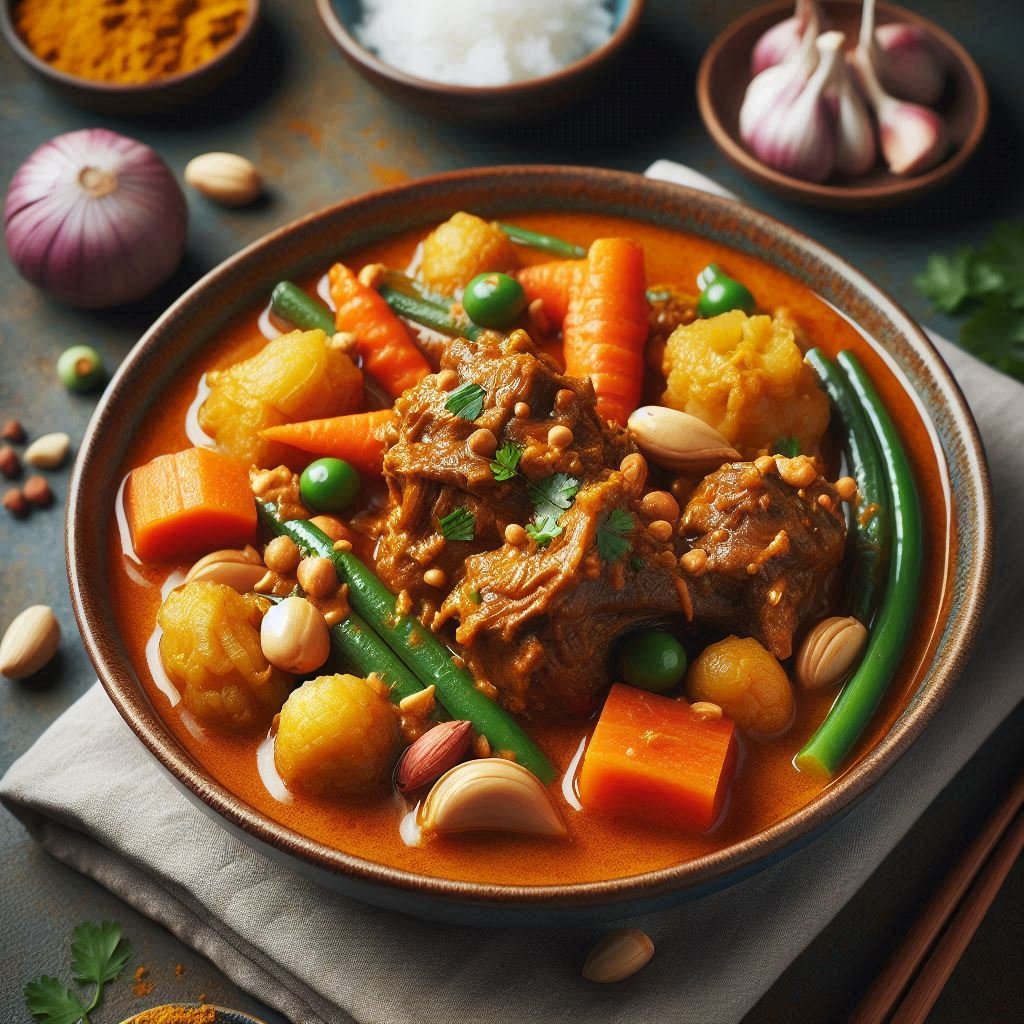Kare-Kare is a quintessential Filipino dish that has captivated taste buds and hearts for generations. This rich, savory stew is renowned for its unique combination of tender oxtail, vibrant vegetables, and a luscious peanut sauce that sets it apart from other Filipino culinary creations. The dish’s name is believed to be derived from the word “curry,” reflecting its possible roots in Indian cuisine, although it has evolved into a distinctly Filipino delicacy. Kare-Kare is not just a meal; it’s a cultural experience that embodies the warmth and complexity of Filipino hospitality and culinary tradition. In this comprehensive guide, we will delve deep into the history, preparation, nutritional aspects, and cultural significance of Kare-Kare, providing you with a thorough understanding of this beloved dish.
The Rich History of Kare-Kare
Origins and Evolution
The origins of Kare-Kare are shrouded in culinary mystery, with several theories attempting to explain its inception. One popular belief suggests that the dish originated in Pampanga, a province in the Philippines known for its rich culinary traditions. Pampanga is often referred to as the “Culinary Capital of the Philippines,” and many attribute the creation of Kare-Kare to the innovative cooks of this region. Another theory posits that Kare-Kare may have been influenced by Indian sepoys (soldiers) who settled in the Philippines during the British occupation in the 18th century. These soldiers, accustomed to curry dishes, may have adapted their recipes using local ingredients, leading to the creation of Kare-Kare.
Cultural Significance
Kare-Kare holds a special place in Filipino cuisine and culture. It is often served during special occasions, family gatherings, and festive celebrations. The dish’s complex flavors and time-consuming preparation make it a symbol of love and care in Filipino households. Kare-Kare is more than just food; it represents the Filipino value of “pakikisama” or togetherness, as it is typically served family-style and enjoyed communally. The act of sharing this hearty stew strengthens bonds and creates lasting memories among family and friends.
Regional Variations
While the basic components of Kare-Kare remain consistent across the Philippines, regional variations have emerged, showcasing the diversity of Filipino cuisine:
- Pampanga Kare-Kare: Known for its rich, thick sauce and the use of ground toasted rice as a thickening agent.
- Cavite Kare-Kare: Often includes a mix of seafood alongside or in place of oxtail.
- Mindanao Kare-Kare: May incorporate coconut milk into the peanut sauce, reflecting the region’s abundant coconut production.
- Vegetarian Kare-Kare: A modern adaptation that replaces meat with an array of vegetables and sometimes tofu.
These variations demonstrate the adaptability and enduring appeal of Kare-Kare across different regions and dietary preferences.
Key Ingredients and Their Roles
The Heart of the Dish: Oxtail
Oxtail is the traditional and most prized meat used in Kare-Kare. This cut of beef comes from the tail of the cow and is prized for its rich flavor and gelatinous texture when cooked slowly. The oxtail’s high collagen content breaks down during the long cooking process, resulting in tender, fall-off-the-bone meat that absorbs the flavors of the peanut sauce beautifully. While oxtail remains the classic choice, some variations of Kare-Kare may include other cuts of beef, tripe, or even pork hocks as alternatives or additions.
The Signature Sauce: Peanut Base
The peanut sauce is what truly defines Kare-Kare and sets it apart from other stews. Traditionally, the sauce is made from ground roasted peanuts or peanut butter, combined with toasted ground rice for thickening. This combination creates a rich, creamy sauce with a subtle nutty flavor that complements the meat and vegetables perfectly. The peanut base not only adds depth to the dish but also provides a unique texture that coats each ingredient, ensuring a burst of flavor in every bite.
Vegetable Medley
Kare-Kare typically includes a variety of vegetables that add color, texture, and nutritional value to the dish. Common vegetables used include:
- Eggplant (Talong): Adds a creamy texture and absorbs the flavors of the sauce.
- String beans (Sitaw): Provides a crisp texture and vibrant green color.
- Banana blossom (Puso ng Saging): Offers a unique, slightly bitter flavor and interesting texture.
- Bok choy or pechay: Contributes a fresh, slightly sweet taste and crisp texture.
These vegetables not only enhance the dish’s nutritional profile but also create a visually appealing presentation that is characteristic of Kare-Kare.
The Essential Condiment: Bagoong
No discussion of Kare-Kare would be complete without mentioning bagoong, a fermented shrimp paste that is an essential accompaniment to the dish. Bagoong provides a salty, umami-rich contrast to the creamy, slightly sweet peanut sauce. Its pungent flavor may be an acquired taste for some, but for many Filipinos, Kare-Kare is incomplete without a dollop of bagoong on the side. The interplay between the rich peanut sauce and the salty bagoong creates a complex flavor profile that is uniquely satisfying.
The Art of Preparing Kare-Kare
Traditional Cooking Method
The preparation of Kare-Kare is a labor of love that requires time, patience, and attention to detail. Here’s an overview of the traditional cooking process:
- Meat Preparation: The oxtail is typically boiled or pressure-cooked until tender, which can take several hours. This step is crucial for achieving the desired texture and extracting flavor from the meat.
- Sauce Creation: Roasted peanuts are ground to a paste, or peanut butter is used as a base. This is combined with toasted ground rice and slowly cooked with broth to create a thick, creamy sauce.
- Vegetable Preparation: Each vegetable is prepared separately to ensure optimal texture. Eggplants and string beans are usually blanched, while banana blossoms are soaked to remove bitterness.
- Assembly: The tender meat is combined with the peanut sauce and simmered to allow the flavors to meld. Vegetables are added towards the end of cooking to prevent overcooking.
- Final Touches: The dish is often garnished with annatto oil for color and served with a side of bagoong.
Modern Adaptations
In recent years, cooks have developed shortcuts and adaptations to make Kare-Kare more accessible for everyday cooking:
- Use of ready-made peanut butter instead of ground peanuts
- Incorporating instant Kare-Kare mix for a quicker sauce base
- Utilizing pressure cookers or slow cookers for more efficient meat tenderizing
- Creating vegetarian versions using plant-based proteins and additional vegetables
While these adaptations may simplify the cooking process, many purists argue that the traditional method yields the most authentic and flavorful results.
Nutritional Profile and Health Considerations
Kare-Kare offers a mix of nutritional benefits and considerations:
| Nutrient | Benefits | Considerations |
|---|---|---|
| Protein | High protein content from oxtail and peanuts | High in saturated fat from oxtail |
| Fiber | Good source from vegetables | Moderate overall fiber content |
| Vitamins | Rich in vitamins A, C, and K from vegetables | Cooking may reduce some vitamin content |
| Minerals | Good source of iron and zinc | High sodium content, especially with bagoong |
| Fats | Contains heart-healthy monounsaturated fats from peanuts | High overall fat content |
Health Benefits
- Protein-rich: Supports muscle growth and repair
- Nutrient-dense vegetables: Provides essential vitamins and minerals
- Peanut content: Offers heart-healthy fats and antioxidants
Health Considerations
- High calorie content: May not be suitable for calorie-restricted diets
- High fat and sodium: Should be consumed in moderation by those with cardiovascular concerns
- Allergies: Contains peanuts, a common allergen
Kare-Kare in Modern Filipino Cuisine
Restaurant Interpretations
In recent years, Filipino chefs have been elevating traditional dishes like Kare-Kare to new heights in the fine dining scene. Innovative interpretations of Kare-Kare can be found in upscale restaurants both in the Philippines and abroad. These modern versions might feature:
- Deconstructed presentations that highlight individual components
- Fusion elements incorporating techniques or ingredients from other cuisines
- Use of premium ingredients like Wagyu beef or organic vegetables
- Creative plating that transforms the rustic stew into an artful dish
These culinary innovations have helped bring Kare-Kare and other Filipino dishes to a global audience, showcasing the sophistication and adaptability of Filipino cuisine.
Home Cooking Trends
The COVID-19 pandemic has sparked a renewed interest in home cooking, with many Filipinos rediscovering traditional recipes like Kare-Kare. Social media platforms have become a hub for sharing recipes, cooking tips, and mouth-watering photos of home-cooked Kare-Kare. This trend has led to:
- Increased experimentation with ingredients and cooking methods
- A focus on healthier versions of Kare-Kare, such as using leaner cuts of meat or incorporating more vegetables
- The development of meal kit services offering pre-portioned ingredients for Kare-Kare
- Virtual cooking classes teaching the art of making authentic Kare-Kare at home
These trends have helped preserve the tradition of Kare-Kare while making it more accessible to a new generation of home cooks.
Cultural Impact and Global Recognition
Kare-Kare in Filipino Identity
Kare-Kare’s significance extends beyond its culinary appeal; it plays a role in shaping Filipino cultural identity. The dish embodies several key aspects of Filipino culture:
- Family-centered dining: The communal nature of eating Kare-Kare reflects the importance of family in Filipino society.
- Resourcefulness: The use of oxtail, once considered a less desirable cut of meat, showcases Filipino ingenuity in creating delicious meals from humble ingredients.
- Patience and dedication: The time-consuming preparation of Kare-Kare mirrors the Filipino value of putting effort and care into important tasks.
- Regional pride: Variations of Kare-Kare highlight the diversity of Filipino cuisine across different regions.
International Recognition
As Filipino cuisine gains recognition on the global stage, Kare-Kare has emerged as one of the ambassadors of Filipino flavors:
- Inclusion in international food festivals and culinary events
- Feature in global food publications and travel shows
- Adoption by non-Filipino chefs in fusion cuisine
- Availability in Filipino restaurants in major cities worldwide
This international exposure has not only introduced Kare-Kare to a wider audience but has also instilled a sense of pride among Filipinos in their culinary heritage.
Pairing and Serving Suggestions
Traditional Accompaniments
Kare-Kare is typically served with several accompaniments that enhance its flavors:
- Steamed white rice: Essential for soaking up the rich peanut sauce
- Bagoong alamang: The fermented shrimp paste that provides a salty counterpoint
- Banana heart: Often served on the side for additional texture and flavor
- Atchara: A pickled green papaya relish that offers a tangy contrast
Beverage Pairings
Choosing the right beverage can complement the rich flavors of Kare-Kare:
- Philippine Citrus Calamansi Juice: Its acidity cuts through the richness of the dish
- San Miguel Beer: A light lager that refreshes the palate
- Coconut Water: Provides a natural, subtle sweetness that balances the savory flavors
- Iced Tea: A refreshing, neutral option that doesn’t overpower the dish
For non-alcoholic options, a cold glass of water with calamansi or lemon can be refreshing and palate-cleansing.
Conclusion
Kare-Kare stands as a testament to the rich culinary heritage of the Philippines. Its complex flavors, intricate preparation, and cultural significance make it more than just a dish; it’s a culinary experience that embodies the heart and soul of Filipino cuisine. From its humble origins to its current status as a beloved national dish, Kare-Kare continues to evolve while maintaining its core identity. Whether enjoyed in a family gathering, a high-end restaurant, or as part of a global food trend, Kare-Kare remains a proud symbol of Filipino culinary artistry and cultural identity. As Filipino cuisine continues to gain recognition worldwide, Kare-Kare will undoubtedly play a crucial role in introducing the vibrant flavors and warm hospitality of the Philippines to food lovers around the globe.
Disclaimer: While every effort has been made to ensure the accuracy of the information presented in this article, culinary traditions and recipes can vary widely. We encourage readers to explore different versions of Kare-Kare and to adapt the dish to their personal tastes and dietary needs. If you notice any inaccuracies or have additional information to contribute, please contact us so we can update our content promptly.




